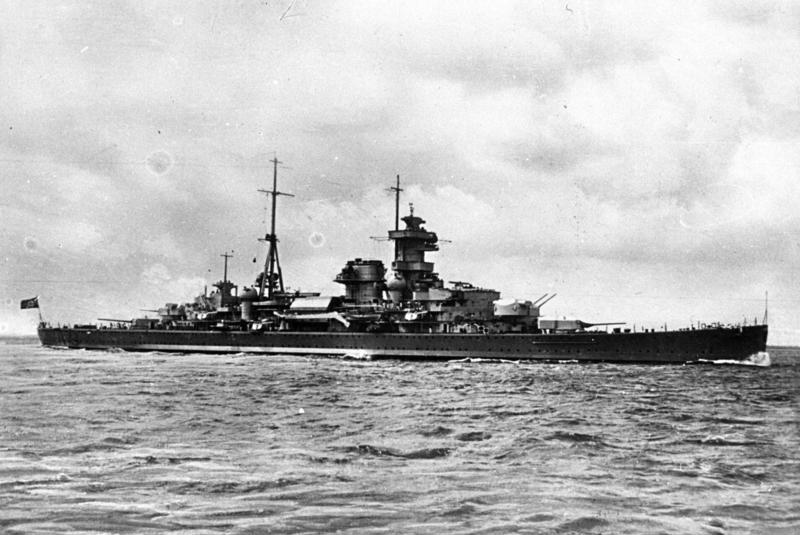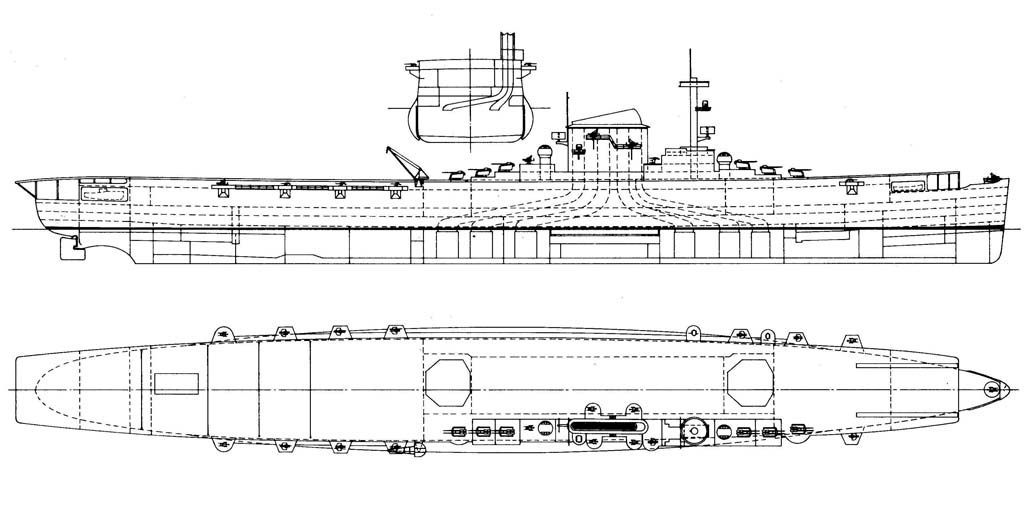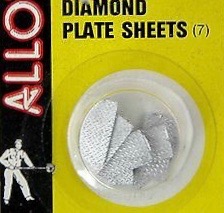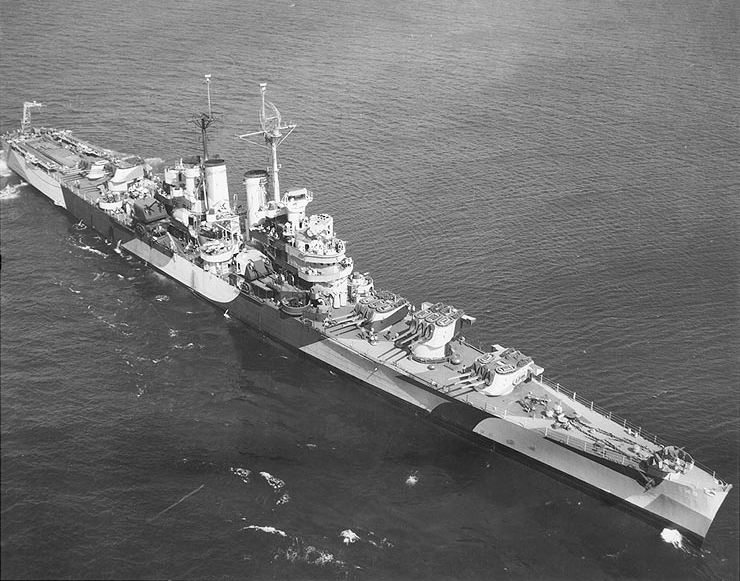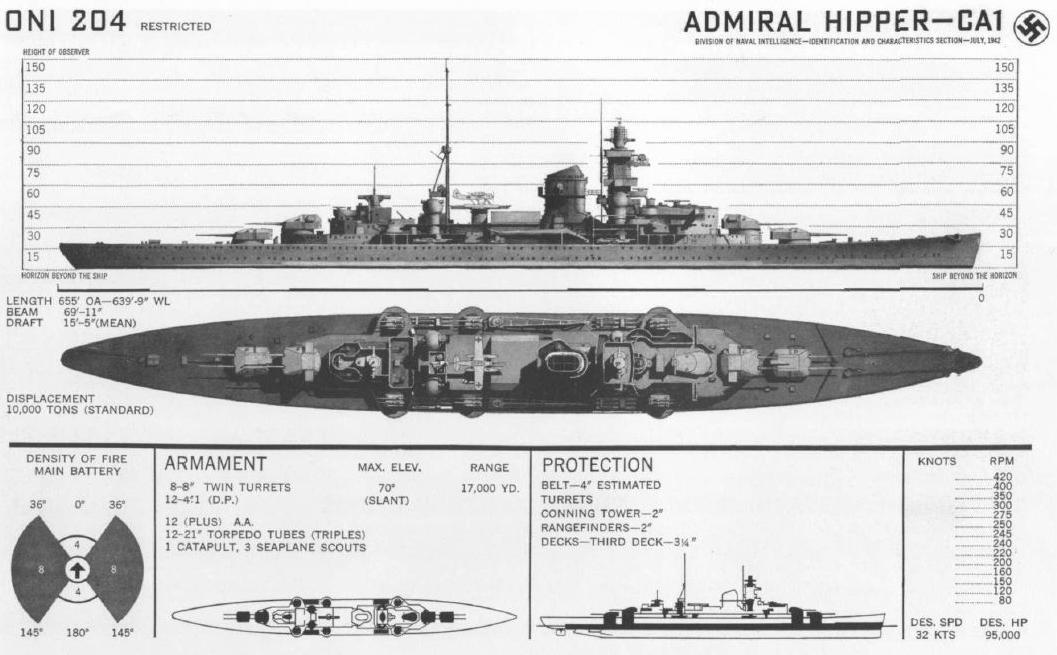History: Admiral Hipper, the first of five ships of her class, was the lead ship of the Admiral Hipper class of heavy cruisers which served with Nazi Germany's Kriegsmarine during World War II. The ship was laid down at the Blohm & Voss shipyard in Hamburg in July 1935 and launched February 1937; Admiral Hipper entered service shortly before the outbreak of war, in April 1939. The ship was named after Admiral Franz von Hipper, commander of the German battlecruiser squadron during the Battle of Jutland in 1916 and later commander-in-chief of the German High Seas Fleet. She was armed with a main battery of eight 20.3 cm (8.0 in) guns and, although nominally under the 10,000-long-ton (10,000 t) limit set by the Anglo-German Naval Agreement, actually displaced over 16,000 long tons (16,000 t).
Admiral Hipper saw a significant amount of action during the war, notably present during the Battle of the Atlantic. She led the assault on Trondheim during Operation Weserübung; while en route to her objective, she sank the British destroyer HMS Glowworm. In December 1940, she broke out into the Atlantic Ocean to operate against Allied merchant shipping, though this operation ended without significant success. In February 1941, Admiral Hipper sortied again, sinking several merchant vessels before eventually returning to Germany via the Denmark Strait. The ship was then transferred to northern Norway to participate in operations against convoys to the Soviet Union, culminating in the Battle of the Barents Sea on 31 December 1942, where she sank the destroyer Achates and the minesweeper Bramble but was in turn damaged and forced to withdraw by the light cruisers HMS Sheffield and HMS Jamaica.
Disappointed by the failure to sink merchant ships in that battle, Adolf Hitler ordered the majority of the surface warships scrapped, though Admiral Karl Dönitz was able to convince Hitler to retain the surface fleet. As a result, Admiral Hipper was returned to Germany and decommissioned for repairs. The ship was never restored to operational status, however, and on 3 May 1945, Royal Air Force bombers severely damaged her while she was in Kiel. Her crew scuttled the ship at her moorings, and in July 1945, she was raised and towed to Heikendorfer Bay. She was ultimately broken up for scrap in 1948–1952 and her bell is currently on display at the Laboe Naval Memorial.
Admiral Hipper saw a significant amount of action during the war, notably present during the Battle of the Atlantic. She led the assault on Trondheim during Operation Weserübung; while en route to her objective, she sank the British destroyer HMS Glowworm. In December 1940, she broke out into the Atlantic Ocean to operate against Allied merchant shipping, though this operation ended without significant success. In February 1941, Admiral Hipper sortied again, sinking several merchant vessels before eventually returning to Germany via the Denmark Strait. The ship was then transferred to northern Norway to participate in operations against convoys to the Soviet Union, culminating in the Battle of the Barents Sea on 31 December 1942, where she sank the destroyer Achates and the minesweeper Bramble but was in turn damaged and forced to withdraw by the light cruisers HMS Sheffield and HMS Jamaica.
Disappointed by the failure to sink merchant ships in that battle, Adolf Hitler ordered the majority of the surface warships scrapped, though Admiral Karl Dönitz was able to convince Hitler to retain the surface fleet. As a result, Admiral Hipper was returned to Germany and decommissioned for repairs. The ship was never restored to operational status, however, and on 3 May 1945, Royal Air Force bombers severely damaged her while she was in Kiel. Her crew scuttled the ship at her moorings, and in July 1945, she was raised and towed to Heikendorfer Bay. She was ultimately broken up for scrap in 1948–1952 and her bell is currently on display at the Laboe Naval Memorial.
Class: The Admiral Hipper-class was a group of five heavy cruisers built by Nazi Germany's Kriegsmarine in the mid-1930s. The class comprised Admiral Hipper, the lead ship, Blücher, Prinz Eugen, Seydlitz, and Lützow. Only the first three ships of the class were completed to see action during World War II. Work on Seydlitz stopped when she was approximately 95 percent complete; it was decided to convert her into an aircraft carrier, but this was not completed either. Lützow was sold incomplete to the Soviet Union in 1940.
Admiral Hipper and Blücher took part in Operation Weserübung, the invasion of Norway in April 1940. Blücher was sunk by Norwegian coastal defenses outside Oslo while Admiral Hipper led the attack on Trondheim. She then conducted sorties into the Atlantic to attack Allied merchant shipping. In 1942, she was deployed to northern Norway to attack shipping to the Soviet Union, culminating in the Battle of the Barents Sea in December 1942, where she was damaged by British cruisers. Prinz Eugen saw her first action during Operation Rheinübung with the battleship Bismarck. She eventually returned to Germany during the Channel Dash in 1942, after which she too went to Norway. After being torpedoed by a British submarine, she returned to Germany for repairs. Admiral Hipper while decommissioned after returning to Germany in early 1943, was partially repaired and recommissioned in the fall of 1944 for a refugee transport mission in 1945. Only Prinz Eugen continued to serve in full commission and stayed in the Baltic until the end of the war.
Admiral Hipper was scuttled in Kiel in May 1945, leaving Prinz Eugen as the only member of the class to survive the war. She was ceded to the US Navy, which ultimately expended the ship in the Operation Crossroads nuclear tests in 1946. Seydlitz was towed to Königsberg and scuttled before the advancing Soviet Army could seize the ship. She was ultimately raised and broken up for scrap. Lützow, renamed Petropavlovsk, remained unfinished when the Germans invaded the Soviet Union. The ship provided artillery support against advancing German forces until she was sunk in September 1941. She was raised a year later and repaired enough to participate in the campaign to relieve the Siege of Leningrad in 1944. She served on in secondary roles until the 1950s, when she was broken up
Admiral Hipper and Blücher took part in Operation Weserübung, the invasion of Norway in April 1940. Blücher was sunk by Norwegian coastal defenses outside Oslo while Admiral Hipper led the attack on Trondheim. She then conducted sorties into the Atlantic to attack Allied merchant shipping. In 1942, she was deployed to northern Norway to attack shipping to the Soviet Union, culminating in the Battle of the Barents Sea in December 1942, where she was damaged by British cruisers. Prinz Eugen saw her first action during Operation Rheinübung with the battleship Bismarck. She eventually returned to Germany during the Channel Dash in 1942, after which she too went to Norway. After being torpedoed by a British submarine, she returned to Germany for repairs. Admiral Hipper while decommissioned after returning to Germany in early 1943, was partially repaired and recommissioned in the fall of 1944 for a refugee transport mission in 1945. Only Prinz Eugen continued to serve in full commission and stayed in the Baltic until the end of the war.
Admiral Hipper was scuttled in Kiel in May 1945, leaving Prinz Eugen as the only member of the class to survive the war. She was ceded to the US Navy, which ultimately expended the ship in the Operation Crossroads nuclear tests in 1946. Seydlitz was towed to Königsberg and scuttled before the advancing Soviet Army could seize the ship. She was ultimately raised and broken up for scrap. Lützow, renamed Petropavlovsk, remained unfinished when the Germans invaded the Soviet Union. The ship provided artillery support against advancing German forces until she was sunk in September 1941. She was raised a year later and repaired enough to participate in the campaign to relieve the Siege of Leningrad in 1944. She served on in secondary roles until the 1950s, when she was broken up
Nationality: Germany is a Western European country with a landscape of forests, rivers, mountain ranges and North Sea beaches. It has over 2 millennia of history. Berlin, its capital, is home to art and nightlife scenes, the Brandenburg Gate and many sites relating to WWII. Munich is known for its Oktoberfest and beer halls, including the 16th-century Hofbräuhaus. Frankfurt, with its skyscrapers, houses the European Central Bank.
Item Links: We found: 1 different collections associated with Admiral Hipper - Cruiser
- Collection War at Sea: 1 different items.
Item created by: Lethe on 2019-03-24 10:01:04. Last edited by Lethe on 2019-08-28 08:11:52
If you see errors or missing data in this entry, please feel free to log in and edit it. Anyone with a Gmail account can log in instantly.
If you see errors or missing data in this entry, please feel free to log in and edit it. Anyone with a Gmail account can log in instantly.


